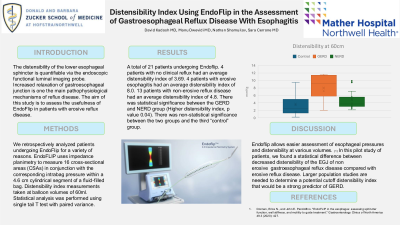Sunday Poster Session
Category: Esophagus
P0506 - Distensibility Index Using EndoFlip in the Assessment of Gastroesophageal Reflux Disease With Esophagitis
Sunday, October 27, 2024
3:30 PM - 7:00 PM ET
Location: Exhibit Hall E

Has Audio

David Kadosh, MD
Mather Hospital, Northwell Health
Port Jefferson, NY
Presenting Author(s)
David Kadosh, MD1, Manu Dwivedi, MD1, Nathan Shamuilov, 2, Sara Cerrone, MD3
1Mather Hospital, Northwell Health, Port Jefferson, NY; 2New York Institute of Technology College of Osteopathic Medicine, Fresh Meadows, NY; 3Northwell Health, Riverhead, NY
Introduction: The distensibility of the lower esophageal sphincter is quantifiable via the endoscopic functional luminal imaging probe. Increased relaxation of gastroesophageal junction is one the main pathophysiological mechanisms of reflux disease. The aim of this study is to assess the usefulness of EndoFlip in patients with reflux disease to determine quantifiable differences in patients with and without esophagitis.
Methods: We retrospectively analyzed 23 patients undergoing EndoFlip for a variety of reasons. EndoFLIP uses impedance planimetry to measure 16 cross-sectional areas in conjunction with the corresponding intrabag pressure within a 4.6 cm cylindrical segment of a fluid-filled bag. Distensibility index measurements were recorded at balloon volumes of 60ml. The primary outcome was distensibility index. Statistical analysis was performed using single tail T test with paired variance.
Results: After excluding 2 patients, a total of 21 patients undergoing Endoflip charts were reviewed. The control group of 4 patients with no clinical reflux had an average index of 3.69. 4 patients with erosive esophagitis with an average distensibility index of 8.0. 13 patients with non-erosive reflux disease had an average distensibility index of 4.8. There was statistical significance between the GERD and NERD group (p value 0.04). There was no statistical significance between the two groups and the third “control” group. There was no statistical difference between patients with and without hiatal hernias. There was no statistical difference between patients with and without contractile response of the esophagus. Patients with normal EJG opening had a distensibility index of 5.97 compared to those with reduced opening with an index of 1.93 (p=0.014).
Discussion: Endoflip allows easier assessment of esophageal pressures and distensibility at various volumes. In this pilot study of patients, we found a statistical difference between dispensability of the EGJ between non erosive and erosive gastroesophageal reflux disease. Limitations includes small sample size which did not allow for enough power to determine a distensibility index cutt off at which esophagitis would be expected. Larger population studies are needed to determine a distensibility index that would be a strong diagnostic predictor of reflux disease.
Note: The table for this abstract can be viewed in the ePoster Gallery section of the ACG 2024 ePoster Site or in The American Journal of Gastroenterology's abstract supplement issue, both of which will be available starting October 27, 2024.
Disclosures:
David Kadosh, MD1, Manu Dwivedi, MD1, Nathan Shamuilov, 2, Sara Cerrone, MD3. P0506 - Distensibility Index Using EndoFlip in the Assessment of Gastroesophageal Reflux Disease With Esophagitis, ACG 2024 Annual Scientific Meeting Abstracts. Philadelphia, PA: American College of Gastroenterology.
1Mather Hospital, Northwell Health, Port Jefferson, NY; 2New York Institute of Technology College of Osteopathic Medicine, Fresh Meadows, NY; 3Northwell Health, Riverhead, NY
Introduction: The distensibility of the lower esophageal sphincter is quantifiable via the endoscopic functional luminal imaging probe. Increased relaxation of gastroesophageal junction is one the main pathophysiological mechanisms of reflux disease. The aim of this study is to assess the usefulness of EndoFlip in patients with reflux disease to determine quantifiable differences in patients with and without esophagitis.
Methods: We retrospectively analyzed 23 patients undergoing EndoFlip for a variety of reasons. EndoFLIP uses impedance planimetry to measure 16 cross-sectional areas in conjunction with the corresponding intrabag pressure within a 4.6 cm cylindrical segment of a fluid-filled bag. Distensibility index measurements were recorded at balloon volumes of 60ml. The primary outcome was distensibility index. Statistical analysis was performed using single tail T test with paired variance.
Results: After excluding 2 patients, a total of 21 patients undergoing Endoflip charts were reviewed. The control group of 4 patients with no clinical reflux had an average index of 3.69. 4 patients with erosive esophagitis with an average distensibility index of 8.0. 13 patients with non-erosive reflux disease had an average distensibility index of 4.8. There was statistical significance between the GERD and NERD group (p value 0.04). There was no statistical significance between the two groups and the third “control” group. There was no statistical difference between patients with and without hiatal hernias. There was no statistical difference between patients with and without contractile response of the esophagus. Patients with normal EJG opening had a distensibility index of 5.97 compared to those with reduced opening with an index of 1.93 (p=0.014).
Discussion: Endoflip allows easier assessment of esophageal pressures and distensibility at various volumes. In this pilot study of patients, we found a statistical difference between dispensability of the EGJ between non erosive and erosive gastroesophageal reflux disease. Limitations includes small sample size which did not allow for enough power to determine a distensibility index cutt off at which esophagitis would be expected. Larger population studies are needed to determine a distensibility index that would be a strong diagnostic predictor of reflux disease.
Note: The table for this abstract can be viewed in the ePoster Gallery section of the ACG 2024 ePoster Site or in The American Journal of Gastroenterology's abstract supplement issue, both of which will be available starting October 27, 2024.
Disclosures:
David Kadosh indicated no relevant financial relationships.
Manu Dwivedi indicated no relevant financial relationships.
Nathan Shamuilov indicated no relevant financial relationships.
Sara Cerrone indicated no relevant financial relationships.
David Kadosh, MD1, Manu Dwivedi, MD1, Nathan Shamuilov, 2, Sara Cerrone, MD3. P0506 - Distensibility Index Using EndoFlip in the Assessment of Gastroesophageal Reflux Disease With Esophagitis, ACG 2024 Annual Scientific Meeting Abstracts. Philadelphia, PA: American College of Gastroenterology.
